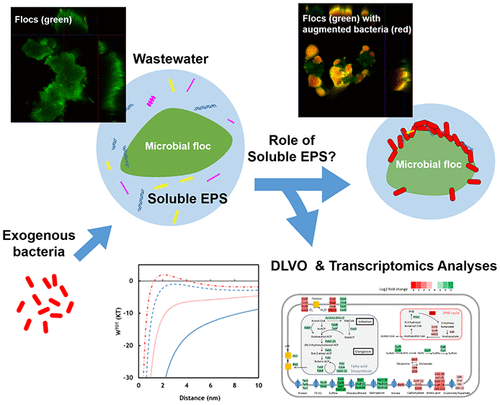当前位置:
X-MOL 学术
›
Environ. Sci. Technol.
›
论文详情
Our official English website, www.x-mol.net, welcomes your
feedback! (Note: you will need to create a separate account there.)
Responses of Exogenous Bacteria to Soluble Extracellular Polymeric Substances in Wastewater: A Mechanistic Study and Implications on Bioaugmentation.
Environmental Science & Technology ( IF 10.8 ) Pub Date : 2020-04-29 , DOI: 10.1021/acs.est.0c00015 Yichao Wu 1, 2 , Norazean Zaiden 2 , Xin Liu 3 , Manisha Mukherjee 2, 4 , Bin Cao 2, 4
Environmental Science & Technology ( IF 10.8 ) Pub Date : 2020-04-29 , DOI: 10.1021/acs.est.0c00015 Yichao Wu 1, 2 , Norazean Zaiden 2 , Xin Liu 3 , Manisha Mukherjee 2, 4 , Bin Cao 2, 4
Affiliation

|
Compared with the chemically defined synthetic wastewater (SynWW), real wastewater has been reported to exhibit distinct effects on microbial community development. Whether and how soluble microbial products in real wastewater contribute to different effects of synthetic and real wastewater on the fate of exogenous bacteria remains elusive. In this study, using a model wastewater bacterium Comamonas testosteroni, we first examined the influences of microfiltration filter-sterilized real wastewater (MF-WW) and SynWW on the retention of C. testosteroni in established wastewater flocs during bioaugmentation. In bioreactors fed with MF-WW, augmentation of C. testosteroni to wastewater flocs resulted in a substantially higher abundance of the augmented bacterial cells than those fed with SynWW. To identify the soluble microbial products in MF-WW contributing to the observed differences between bioaugmentation reactors fed with MF-WW and SynWW, we examined the effect of MF-WW and SynWW on the growth, floc formation, and biofilm development of C. testosteroni. When C. testosteroni grew in MF-WW, visible flocs formed within 2 h, which is in contrast to cell growth in SynWW where floc formation was not observed. We further demonstrated that the observed differences were mainly attributed to the high molecular weight fraction of the soluble extracellular polymeric substances (EPS) in MF-WW, in particular, proteins and extracellular DNA. The DLVO analysis suggested that, in the presence of soluble EPS, the bacterial cell surface exhibits an increased hydrophobicity and a diminished energy barrier, leading to irreversible attachment of planktonic cells and floc formation. The RNA-seq based transcriptional analysis revealed that, in the presence of soluble EPS, genes involved in nonessential metabolisms were downregulated while genes coding for Cco (cbb3-type) and Cox (aa3-type) oxidases with different oxygen affinities were upregulated, facilitating bacterial survival in flocs. Taken together, this study reveals the mechanisms underlying the contribution of soluble EPS in real wastewater to the recruitment of exogenous bacteria by microbial aggregates and provides implications to bioaugmentation.
中文翻译:

外源细菌对废水中可溶性细胞外聚合物的响应:机理研究及其对生物强化的影响。
与化学定义的合成废水(SynWW)相比,据报道,实际废水对微生物群落的发展具有明显的影响。实际废水中的可溶性微生物产品是否以及如何影响合成废水和实际废水对外源细菌命运的不同影响,目前尚不清楚。在这项研究中,我们使用模型废水细菌Comamonas testosteroni,首先研究了微滤滤池灭菌的真实废水(MF-WW)和SynWW对生物强化过程中已建立的废水絮体中C. testosteroni保留的影响。在MF-WW饲喂的生物反应器中,睾丸梭菌的增加与废水中的絮凝物相比,SynWW喂养的细菌细胞的丰度大大提高。为了鉴定MF-WW中的可溶性微生物产物,从而有助于观察到MF-WW和SynWW进料的生物强化反应器之间的差异,我们检查了MF-WW和SynWW对C.睾丸激素的生长,絮凝物形成和生物膜发育的影响。。当C.睾丸激素在MF-WW中生长,可见的絮凝物在2小时内形成,这与SynWW中未观察到絮凝物形成的细胞生长相反。我们进一步证明,观察到的差异主要归因于MF-WW中可溶性细胞外聚合物(EPS)的高分子量部分,特别是蛋白质和细胞外DNA。DLVO分析表明,在存在可溶性EPS的情况下,细菌细胞表面显示出增加的疏水性和减小的能垒,从而导致浮游细胞的不可逆附着和絮凝物形成。基于RNA序列的转录分析表明,在可溶性EPS的存在下,参与非必需代谢的基因被下调,而编码Cco(cbb 3型)和Cox(aa具有不同氧亲和力的3型)氧化酶被上调,促进了絮凝物中细菌的存活。两者合计,这项研究揭示了实际废水中可溶性EPS有助于微生物聚集体招募外源细菌的潜在机制,并为生物强化提供了启示。
更新日期:2020-04-29
中文翻译:

外源细菌对废水中可溶性细胞外聚合物的响应:机理研究及其对生物强化的影响。
与化学定义的合成废水(SynWW)相比,据报道,实际废水对微生物群落的发展具有明显的影响。实际废水中的可溶性微生物产品是否以及如何影响合成废水和实际废水对外源细菌命运的不同影响,目前尚不清楚。在这项研究中,我们使用模型废水细菌Comamonas testosteroni,首先研究了微滤滤池灭菌的真实废水(MF-WW)和SynWW对生物强化过程中已建立的废水絮体中C. testosteroni保留的影响。在MF-WW饲喂的生物反应器中,睾丸梭菌的增加与废水中的絮凝物相比,SynWW喂养的细菌细胞的丰度大大提高。为了鉴定MF-WW中的可溶性微生物产物,从而有助于观察到MF-WW和SynWW进料的生物强化反应器之间的差异,我们检查了MF-WW和SynWW对C.睾丸激素的生长,絮凝物形成和生物膜发育的影响。。当C.睾丸激素在MF-WW中生长,可见的絮凝物在2小时内形成,这与SynWW中未观察到絮凝物形成的细胞生长相反。我们进一步证明,观察到的差异主要归因于MF-WW中可溶性细胞外聚合物(EPS)的高分子量部分,特别是蛋白质和细胞外DNA。DLVO分析表明,在存在可溶性EPS的情况下,细菌细胞表面显示出增加的疏水性和减小的能垒,从而导致浮游细胞的不可逆附着和絮凝物形成。基于RNA序列的转录分析表明,在可溶性EPS的存在下,参与非必需代谢的基因被下调,而编码Cco(cbb 3型)和Cox(aa具有不同氧亲和力的3型)氧化酶被上调,促进了絮凝物中细菌的存活。两者合计,这项研究揭示了实际废水中可溶性EPS有助于微生物聚集体招募外源细菌的潜在机制,并为生物强化提供了启示。


















































 京公网安备 11010802027423号
京公网安备 11010802027423号